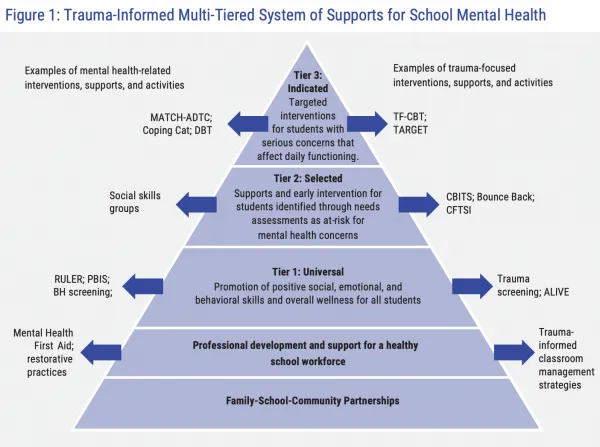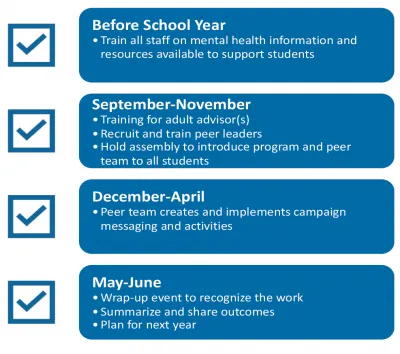Issue Brief 90: Students Helping Students

The emotional well-being of students is a pressing concern for schools, particularly since the onset of the COVID-19 pandemic. Schools have increasingly recognized the important connections between behavioral health*, academic functioning, and school climate. Nearly 70% of Connecticut students in 2021 reported that their mental health was “not good” in the past month, and only 25% of these students accessed needed supports and services.1 Similar national trends have been observed for behavioral health and exposure to adverse childhood experiences (ACEs), which are linked to higher rates of behavioral health concerns and suicide.2,3
In 2022, Connecticut advanced peer support programs as a strategy for supporting student behavioral health by passing Public Act 22-47. The legislation required the Department of Children and Families (DCF), in collaboration with the State Department of Education (SDE), to develop a “peer-to-peer mental health support program” and make it available to schools and youth-serving organizations in the state (Section 34-35). To help the state implement the peer support program, CHDI conducted a review of 20 school-based peer support program models and summarized common elements across these approaches (see Figure 2).4
This Issue Brief examines peer support models as an innovative strategy schools can use to support student behavioral health and improve school climate within a Comprehensive School Mental Health (CSMH) approach. It also summarizes CHDI’s review of peer support models and includes recommendations for state policymakers and school districts to incorporate and sustain effective peer-led support programs in schools.
In 2021, nearly 70% of Connecticut students reported that their mental health in the past month was “not good," and only 25% of these students accessed needed supports and services.
Peer support programs can benefit students and schools
During adolescence, a growing sense of identity and autonomy often result in seeking more support from social networks (e.g., peers) and less from family or caregivers.5 Adolescents increasingly turn to classmates and friends for support, advice, and to talk through difficult experiences. Evidence suggests that these types of peer supports can protect against stress, depression, anxiety, and suicidality, and promote self-esteem, mental health, and optimism.6
Peer support programs can equip students with:
-
Accurate information regarding behavioral health and coping strategies
- Communication skills to talk with and support classmates who may be struggling
- Connections to resources and trusted adults
School-based peer support programs are modeled from the peer support programs in clinical settings for behavioral health, which are used as an adjunct to traditional behavioral health services, and have been found to significantly improve outcomes for recipients.7,8 These programs involve identifying peer leaders to educate and bring awareness about behavioral health and to provide informal support to peers who may be experiencing distress until they can access more formal support or services.
It is important to note that peer leaders in school settings are not acting as therapists or providing professional advice, but instead provide general information and support as peers and explain and offer connections as needed with formal services or resources, such as counselors or trusted adults.
Peer support programs show promise in supporting student mental health
Research on peer support programs in clinical settings has shown significant benefits in health and mental health outcomes for the recipients and the peer leaders, and the benefits may be particularly promising for participants with marginalized identities. These programs increase access and trust by allowing for more flexibility to address individual needs (e.g., being able to offer services during hours that are more convenient to participants), providing opportunities for direct engagement in their own care, and enhancing community partnerships and communication).9
Similar to clinical peer support models, school-based programs have also shown moderate success. Students who serve in peer leader roles indicated increased mental health literacy, knowledge about available resources, confidence in referring their classmates to resources, and sense of self-esteem.10,11 For students who receive peer support or participate in program events, research demonstrates positive outcomes in quality of life and self-confidence.10,12
Additionally, there is evidence to suggest that peer programs are better suited to target the student body as whole (i.e., universal prevention), as opposed to singling out students who may be deemed “at risk”, to avoid unintended negative effects on mental health.10
No current research was identified that examined the effects of school-based peer support programs on equity or disparities for students by race, ethnicity, gender, LGBTQI status, or related factors. The emerging evidence suggests that peer support programs should be included in CSMH approaches.
Peer support programs complement a comprehensive school mental health approach
Schools are a natural setting to support behavioral health and well-being because most children attend school. Using a CSMH approach to address students’ behavioral health needs can also improve students’ academic outcomes and school climate. In 2018, CHDI partnered with the National Center for School Mental Health at the University of Maryland to develop a CSMH framework for Connecticut policymakers and school districts (Figure 1).13
A key feature of this CSMH approach is to build a network of tiered supports between school programs, behavioral health service providers, and community resources, and build strong partnerships with families.14 This process is typically guided by a needs assessment, such as The School Health Assessment and Performance Evaluation (SHAPE) system, to identify strengths and areas of improvement for supporting student well-being. Peer support programs can be implemented within a CSMH approach to support student well-being and connect students with additional services as needed.

Key components of peer support programs used to develop a best practice model for Connecticut schools
To help the state develop and implement the peer support program called for in Public Act 22-47, CHDI conducted a review of 20 school-based peer support program models and summarized common elements across these approaches (see Figure 2).4 These programs often include training school staff and administrators on general mental health topics and how to support students who may be struggling. Additional training for the adult advisors and peer leaders, who are often identified through self-nomination or peer/teacher nomination, typically includes information about behavioral health, recognizing signs and strategies to support someone in distress, communication and listening skills, coping skills, and knowledge of available local and national resources.
Peer leaders are tasked with creating a student-led campaign to raise awareness about behavioral health, warning signs, coping skills, and send encouraging messages to reduce stigma about seeking help or accessing services and supports. These campaigns might include messaging and posters, social media posts, assemblies and information presentations, and/or other activities developed by the peer leaders to increase knowledge and promote open conversations about behavioral health. Many of the programs reviewed only briefly addressed substance abuse prevention as a component of behavioral health or did not mention substance use at all.
In addition, peer support programs provide a unique opportunity to support equity and anti-racism. Utilizing a participatory approach to intervention, in which students are directly and actively involved in the planning and implementation processes, allows perspectives about their own experiences to be heard and included.15 Peer leaders are often influential or well-known students representing a range of social and demographic groups to ensure they accurately represent the broader student population and may understand unique struggles based on students’ backgrounds. Additionally, these programs present an opportunity to include direct information about how students’ identities can intersect with behavioral health, such as experiences of racism or discrimination.
Figure 2. Peer Support Program Components and Timeline

There were only three programs reviewed that included most or all of the components mentioned above and had detailed materials, implementation supports, and evidence of effectiveness: the Michigan Peer-to-Peer program, Sources of Strength, and HopeSquad.
CHDI is developing a Connecticut Peer Support Program modeled after the key components found in other existing programs, particularly the Michigan Peer-to-Peer program because it addressed mental health and well-being in addition to suicide prevention.
Recommendations
The following recommendations provide guidance for incorporating and sustaining peer-led support programs in schools:
Include a peer support model as part of a CSMH approach
Schools and districts should consider including a peer-led support program model as part of their CSMH approach. CHDI is developing the Connecticut Peer Support Program as required by PA 22-47, modeled after existing evidence-based peer support programs. The new model will be available to schools in 2024 and will include materials and a detailed implementation guide for how to prepare for and implement the program.
Consider other established peer support models
School or district leaders that want to implement a peer support model prior to the completion of the Connecticut pilot may consider the following programs, which have evidence of success, detailed program materials, and implementation support:
-
Michigan Peer-to-Peer Program: Focused on general mental health knowledge, reducing stigma, and help-seeking behavior.
- Sources of Strength: Focused primarily on suicide prevention.
- HopeSquad: Focused primarily on suicide prevention.
Collect data and evaluate outcomes
Schools should collect data about program utilization and impact at the beginning and end of the school year to evaluate program outcomes and to make improvements. Results should be shared with school staff, caregivers, and students.
Evaluation could also integrate existing school data (e.g., attendance, academic achievement, discipline, school climate) to examine any impacts on these outcomes.
State funding for peer support implementation
Because Public Act 22-47 only provided funding for the initial development of the program materials, legislators or state agencies should provide funding for the implementation and evaluation of the Connecticut Peer Support Program to ensure districts can use the program and to evaluate the effectiveness of the program. This should include partnering with external evaluators to conduct a formal evaluation of the implementation and impact of the program.
This Issue Brief was prepared by Mackenzie Wink, PhD and Jason Lang, PhD.
For the latest updates on the student peer support program CHDI is piloting in Connecticut, visit the Students Supporting Students page.
*The term “behavioral health” describes a broad spectrum of concerns related to the emotional and behavioral needs of students, including well-being, resilience, mental health, and substance use prevention. Download the Issue Brief (PDF)References
-
Connecticut School Health Survey (CSHS; 2021). https://portal.ct.gov/-/media/DPH/CSHS/2021/2021_CSHS_Graphs_Trends_web.pdf
-
Anderson, K. N., Swedo, E. A., Trinh, E., Ray, C. M., Krause, K. H., Verlenden, J. V., Clayton, H. B., Villaveces, A., Massetti, G. M., & Holditch Niolon, P. (2022). Adverse Childhood Experiences During the COVID-19 Pandemic and Associations with Poor Mental Health and Suicidal Behaviors Among High School Students - Adolescent Behaviors and Experiences Survey, United States, January-June 2021. Morbidity and mortality weekly report, 71(41), 1301–1305. https://doi.org/10.15585/mmwr.mm7141a2
-
Centers for Disease Control and Prevention (2021). Youth Risk Behavior Survey Data Summary & Trends Report. https://www.cdc.gov/healthyyouth/data/yrbs/pdf/YRBS_Data-Summary-Trends_Report2023_508.pdf
-
Child Health and Development Institute (2023). Peer-Led School Mental Health Programs: A Review and Recommendations for a Model in Connecticut Schools.
-
National Academies of Sciences, Engineering, and Medicine. (2020). Promoting Positive Adolescent Health Behaviors and Outcomes: Thriving in the 21st Century. Washington, DC: The National Academies Press. https://doi.org/10.17226/25552
-
Roach, A. (2018). Supportive peer relationships and mental health in adolescence: An integrative review. Issues in mental health nursing, 39(9), 723-737. https://doi.org/10.1080/01612840.2018.1496498
-
Shalaby, R. A. H., & Agyapong, V. I. (2020). Peer support in mental health: literature review. JMIR mental health, 7(6), e15572. https://doi.org/10.2196/15572
-
Smit, D., Miguel, C., Vrijsen, J. N., Groeneweg, B., Spijker, J., & Cuijpers, P. (2022). The effectiveness of peer support for individuals with mental illness: systematic review and meta-analysis. Psychological Medicine, 1-10.
-
Sokol, R., & Fisher, E. (2016). Peer Support for the Hardly Reached: A Systematic Review. American journal of public health, 106(7), e1–e8. https://doi.org/10.2105/AJPH.2016.303180
-
King, T., & Fazel, M. (2021). Examining the mental health outcomes of school-based peer-led interventions on young people: A scoping review of range and a systematic review of effectiveness. PloS one, 16(4). https://doi.org/10.1371/journal.pone.0249553
-
Wade, L., Leahy, A. A., Babic, M. J., Beauchamp, M. R., Smith, J. J., Kennedy, S. G., Boyer, J., Nathan, N., Robinson, K., & Lubans, D. R. (2022). A systematic review and meta-analysis of the benefits of school-based, peer-led interventions for leaders. Scientific Reports, 12(1), 21222. https://doi.org/10.1038/s41598-022-25662-9
-
Manchanda, T.; Stein, A.; Fazel, M. (2023). Investigating the Role of Friendship Interventions on the Mental Health Outcomes of Adolescents: A Scoping Review of Range and a Systematic Review of Effectiveness. International Journal of Environmental Research and Public Health, 20, 2160. https://doi.org/10.3390/ijerph20032160
-
Hoover, S., Bracey, J., Lever, N., Lang, J., Vanderploeg, J. Healthy Students and Thriving Schools: A Comprehensive Approach for Addressing Students’ Trauma and Mental Health Needs. Farmington, CT: Child Health and Development Institute of Connecticut. 2018.
-
Hoover, S., Lever, N., Sachdev, N., Bravo, N., Schlitt, J., Acosta Price, O., Sheriff, L. & Cashman, J. (2019). Advancing Comprehensive School Mental Health: Guidance From the Field. Baltimore, MD: National Center for School Mental Health. University of Maryland School of Medicine.
-
Anyon, Y., Bender, K., Kennedy, H., & Dechants, J. (2018). A systematic review of youth participatory action research (YPAR) in the United States: Methodologies, youth outcomes, and future directions. Health Education & Behavior, 45(6), 865-878. https://doi.org/10.1177/1090198118769357
Our work: Comprehensive School Mental Health
Learn more about our work to help schools support students' mental health needs.